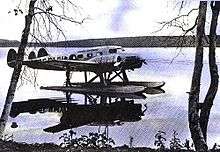Barkley-Grow T8P-1
| T8P-1 | |
|---|---|
| | |
| CF-BLV while under restoration at the Aero Space Museum, Calgary, Alberta c. 2000 | |
| Role | Airliner |
| Manufacturer | Barkley-Grow Aircraft |
| Designer | Archibald Barkley |
| First flight | April 1937 |
| Number built | 11 |
|
| |
The Barkley-Grow T8P-1 was an airliner developed in the United States shortly before the Second World War. Although it saw limited production, the type was well-received as a bush plane in Canada.
Design and development
Typical for the era, the Barkley-Grow T8P-1 was a low-wing monoplane of all-metal construction with a twin tail (an additional third tail was installed, à la Lockheed Constellation, when fitted with floats). The T8P (standing for Transport, 8 Passenger) was designed to be simple and rugged, thus the main units of the tailwheel undercarriage were not retractable, and this may have negatively impacted the type's reception in the marketplace. A novel design feature, however, was the wing structure. Barkley used what might be called a "horizontal cell" technique that has no ribs or spars. Long tapered strips of aluminium were bent to form V shapes which were then riveted tip to tip to form an "X". These "X"s are riveted inside the wing side by side to produce the long "cells". This wing structure was unique to the Barkley-Grow and according to mechanics who worked on the aircraft it was very light, very stiff, very expensive to build, and difficult to repair if damaged, but it gave no problems in service.[1]
Like its two main competitors, the Lockheed Model 12 Electra Junior and the Beech 18, the T8P-1 was originally designed to a 1935 Bureau of Air Commerce specification (eventually won by the Lockheed entry).[1]

Operational history
Sales in the US were disappointing, only 11 being built, and most machines (seven) were sold to Canada, where the fixed undercarriage was no obstacle to the fitting of skis or pontoons. One was selected for a record flight from Washington D.C. to Peru, and another was used in the Antarctic by the US Navy.
In 1942 A T8P-1 flown by Maritime Central Airways was used in the rescue attempt of survivors of a B-17 on the Greenland ice shelf. The aircraft was fitted with skis but force-landed on the ice on 22 December 1942 after encountering strong headwinds. The T8P-1 broke through the ice and sank leaving the pilots to be rescued by Inuit tribesman.[2][3][4]
Survivors
Three examples are preserved at the Aero Space Museum, Calgary, Reynolds-Alberta Museum, Wetaskiwin, and at the Alberta Aviation Museum, Edmonton.[1]
Specifications
Data from General Dynamics Aircraft and their Predecessors[5]
General characteristics
- Crew: two pilots
- Capacity: 6 passengers or 1,397 (634 kg) of cargo
- Length: 36 ft 8 in (10.87 m)
- Wingspan: 50 ft 8¾ in (15.47 m)
- Height: 9 ft 7½ in (2.93 m)
- Wing area: 354 ft2 (32.9 m2)
- Empty weight: 5,365 lb (2,439 kg)
- Gross weight: 8,750 lb (3,977 kg)
- Powerplant: 2 × Pratt & Whitney Wasp Junior SB radial engines, 400 hp (298 kW) each each
Performance
- Maximum speed: 225 mph (362 km/h)
- Cruise speed: 204 mph (328 km/h)
- Range: 630 miles (1,014 km)
- Service ceiling: 24,000 ft (7,320 m)
- Rate of climb: 1,420 ft/min (7.2 m/s)
See also
- Related lists
References
- Notes
- 1 2 3 "Dibnah, Larry. "The Barkley-Grow T8P-1. (In My Travels)." Archived July 11, 2011, at the Wayback Machine. The Patrician, Victoria Flying Club, February 2007. Retrieved: December 7, 2009.
- ↑ "Greenland Air Crash". Retrieved 25 October 2013.
- ↑ Mitchell Zuckoff. Frozen in Time: An Epic Story of Survival and a Modern Quest for Lost Heroes.
- ↑ http://librarum.org/book/35333/88[]
- ↑ Wegg 1990, p. 172.
- Bibliography
- Gerritmas, Joop and Hazewinkel Harm. "The Barkley-Grow T8P-1." AAHS Journal 50 (4), 2005.
- Taylor, J.H. Jane's Encyclopedia of Aviation. London: Studio Editions, 1989, p. 121. ISBN 0-517-10316-8.
- Wegg, John. General Dynamics Aircraft and their Predecessors. London: Putnam, 1990. ISBN 0-85177-833-X.
- World Aircraft Information Files (File 890 Sheet 02). London: Bright Star Publishing.
External links
| Wikimedia Commons has media related to Barkley-Grow T8P-1. |